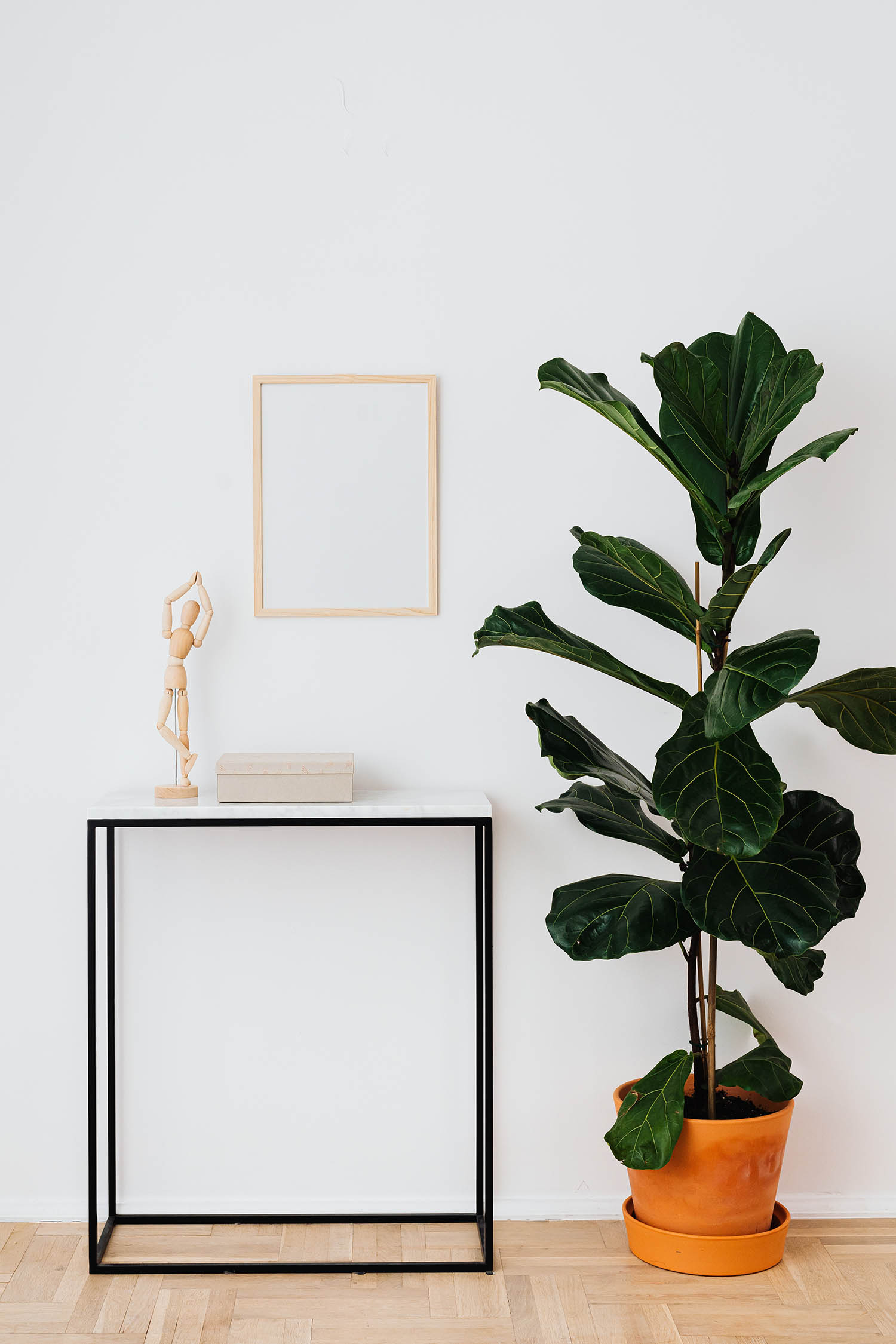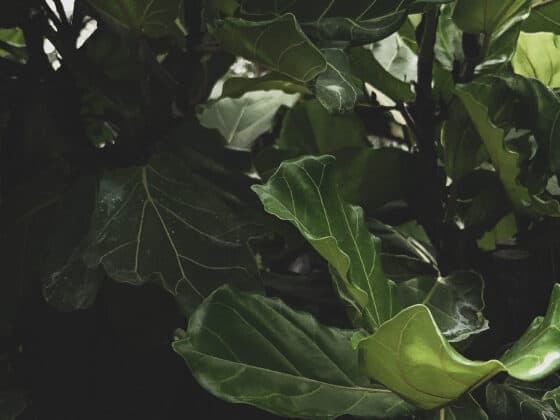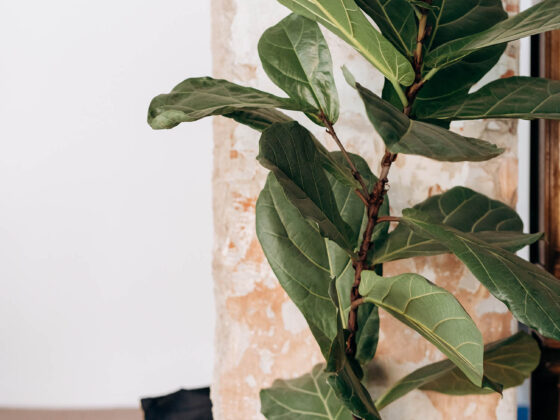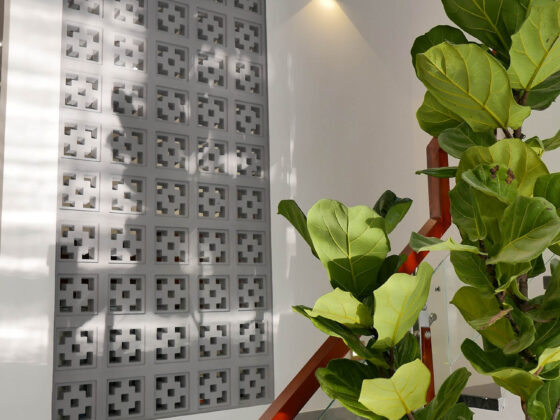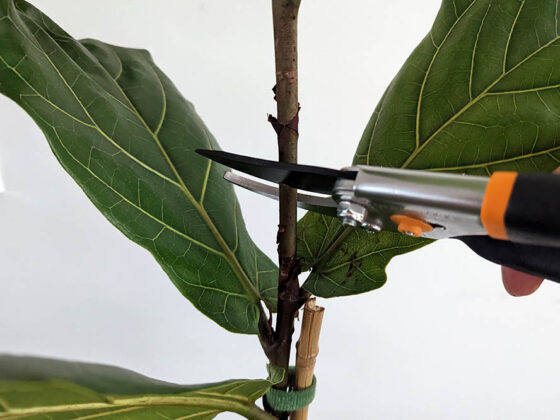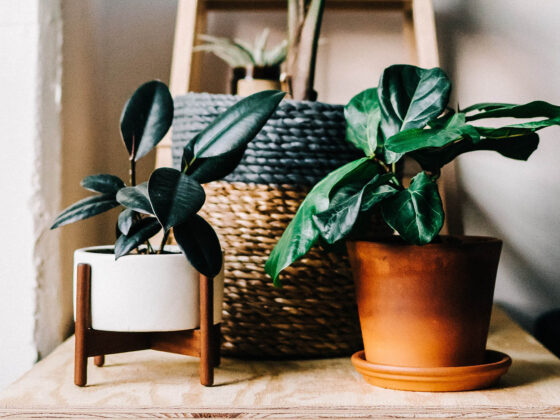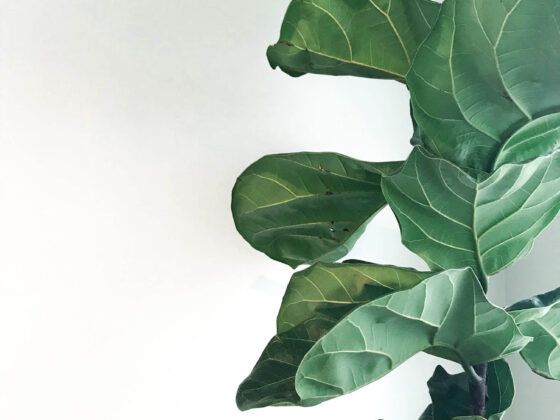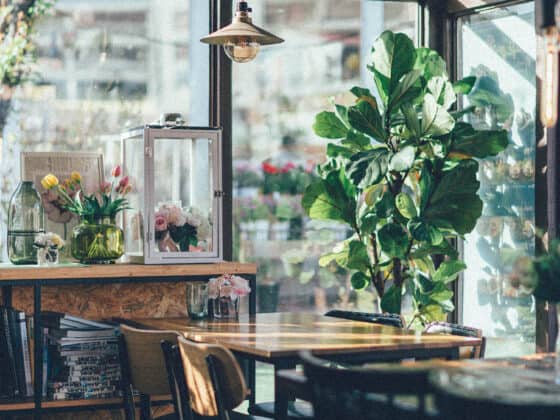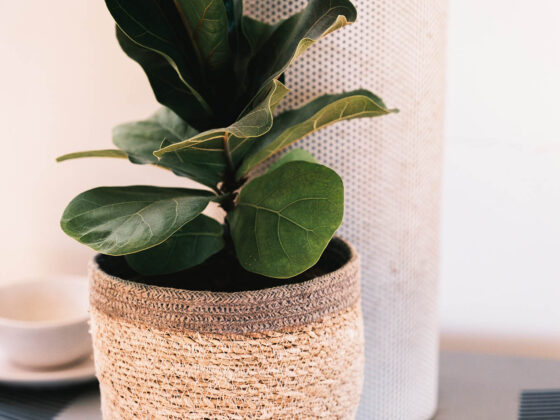As a plant enthusiast, you probably already know that nothing sets off alarm bells quite like a cherished houseplant losing its leaves. In the case of the Fiddle Leaf Fig (Ficus lyrata), a plant beloved for its unique foliage, it can be devastating watching your plant’s health decline before your eyes. So, what causes leaf drop? And what can you do to save your Fig?
When a Fiddle Leaf Fig loses its leaves, it’s usually because of a watering issue, lack of sunlight, or from shock from varying environmental conditions. While leaf drop can happen quickly, small improvements to the plant’s care and environment are usually all that is needed to correct the problem.
If you’ve ever witnessed your Fig dropping leaves, you know it can be a panic-inducing situation. However, knowing why a Fiddle Leaf sheds otherwise healthy leaves can help you quickly diagnose and correct any factors that may contribute to your plant’s declining health.
In this article, I’ll walk you through the most common reasons (and a few less-common reasons) why Fiddle Leaf Figs drop leaves and what you can do to save your plant and prevent it from happening in the future.
What to Expect from a Healthy Fiddle Leaf Fig?
Before we get into it, it might be beneficial to know what to expect from your Fiddle Leaf when it is happy, healthy, and thriving in your home. Generally, Fiddle Leaf Figs are moderately fast growers that tend to grow a few to several inches in height throughout a growing season. Most of this growth occurs at the plant’s apical meristem or growing tip.
If your Fig isn’t branched at all, you’ll likely find that it pushes several inches from its one growth tip and can reach a height of six to eight feet rather quickly over the course of only a couple of seasons. If you have a well-branched specimen, you can see that growth occurs at each branch tip, giving the plant a bushier appearance.
New growth frequently appears when your Fig has everything it needs, with new, glossy leaves stacking neatly atop sturdy stems and branches. New leaves start small and may look pale or discolored, but they will quickly deepen in color and grow to a similar size as other leaves on the plant. In many cases, Fiddle Leaf Figs tend to have leaves well distributed all over the plant, with only the oldest parts of the stem looking bare.
You can dive deeper into the signs your Fiddle Leaf Fig is thriving by reading an article I wrote on the subject. Click here to read: Is Your Fiddle Leaf Fig Healthy? Six Signs of Healthy Trees.
A Quick Note About Old Age
If you are lucky enough to have an older Fiddle Leaf, you may notice that your plant sheds a leaf from time to time even though it looks totally healthy in all other aspects. Don’t worry about the occasional leaf dropping from your Fig! As the plant grows and matures, the oldest leaves begin to succumb to the ravages of time, and your Fig will discard them and put energy into producing new, more productive leaves.
Leaf drop is only a problem when it happens fast and usually without much warning. Older leaves that aren’t long for this world will start to look leathery and dry. They may fade in color as your Fig begins redirecting resources to more productive parts of the plant before they eventually fall off. This is all a natural part of your plant’s lifecycle and shouldn’t concern you at all.
Five Likely Reasons Your Fiddle Leaf Fig is Losing Leaves
Aside from your Fiddle Leaf shedding its oldest leaves in favor of new, productive ones, any other leaf loss should be met with some concern. Figs tend to hold onto their leaves for a long time, so when the plant starts dropping them, there’s usually an underlying issue that needs to be addressed before the problem worsens.

Overwatering and Root Rot
By far, the most common reason people find their Fiddle Leaf Fig dropping its leaves is from complications due to overwatering. Too much water often leads to root rot. Root rot is a condition that starts in the roots and can spread throughout the plant, which results in the plant shedding its leaves.
When a Fig becomes overwatered, either from getting watered too frequently or because of poor drainage in the soil and pot, the root system becomes waterlogged and is denied adequate oxygen, allowing microorganisms present in the soil to attack the roots and cause them to rot away. As the root system dies, essential functions like water regulation, nutrient absorption, and gas exchange are severely hindered, causing a stress response in the plant. As this problem progresses, the rot can begin to spread up into the leaves.
In response to the inadequate amount of nutrients and the prevailing rot, your Fig will kick into survival mode, and to preserve the newest, most efficient growth, it will start dropping affected leaves, usually starting near the bottom of the plant.
Generally, leaf drop due to overwatering will also be accompanied by other telltale signs that your plant is too wet. Often, the leaves that drop from the plant can be yellow in color (an early warning sign of too much moisture) or, in more severe cases of root rot, have irregular, brown spots that start in the center of the leaves. Lower leaves are usually impacted early and will drop first.
What To Do About It
If you suspect your Fig is dropping leaves due to overwatering, you need to take quick action to correct the issue. First and foremost, let your Fig dry out. You need to give your Fig time to recover and allow the roots to resume normal function, which can only happen when the soil is no longer waterlogged.
If you see brown spots on any leaves, you need to make sure your plant isn’t suffering from root rot. This will likely require you to remove the plant from its container and inspect the roots. Brown, mushy roots are dead and won’t recover, so they need to be cut out. The remaining roots should all look plump and white. Remove as much soil from the remaining healthy roots as you can.
Repot your Fig into a clean container with fresh, well-draining potting soil. It might take your Fig some time to recover from both the trauma of repotting and the reduction in the root system, but clearing the plant of rot is the most important task at this point.
Moving forward, only water when the top two inches of soil have dried out completely. When you do so, water the plant deeply, allowing excess liquid to drain through the soil and out the bottom of the pot. This method ensures adequate moisture is being held in the soil for the Fiddle Leaf to utilize as needed without waterlogging the fragile root system.
Suspect your plant has root rot and need more step-by-step instructions for rescuing it? Read this article.
Underwatering
Another reason a Fiddle Leaf Fig might drop its leaves is due to underwatering. While far less common than overwatering, too little moisture can put a lot of stress on your Fig, causing it to drop leaves as a survival mechanism, preserving what little moisture remains in the plant.
As your Fiddle Leaf Fig dries out, the plant begins to take measures to hold onto whatever moisture it can to keep essential functions going. New growth is paused, respiration is reduced, and you may notice that the tips of leaves begin to dry out and brown.
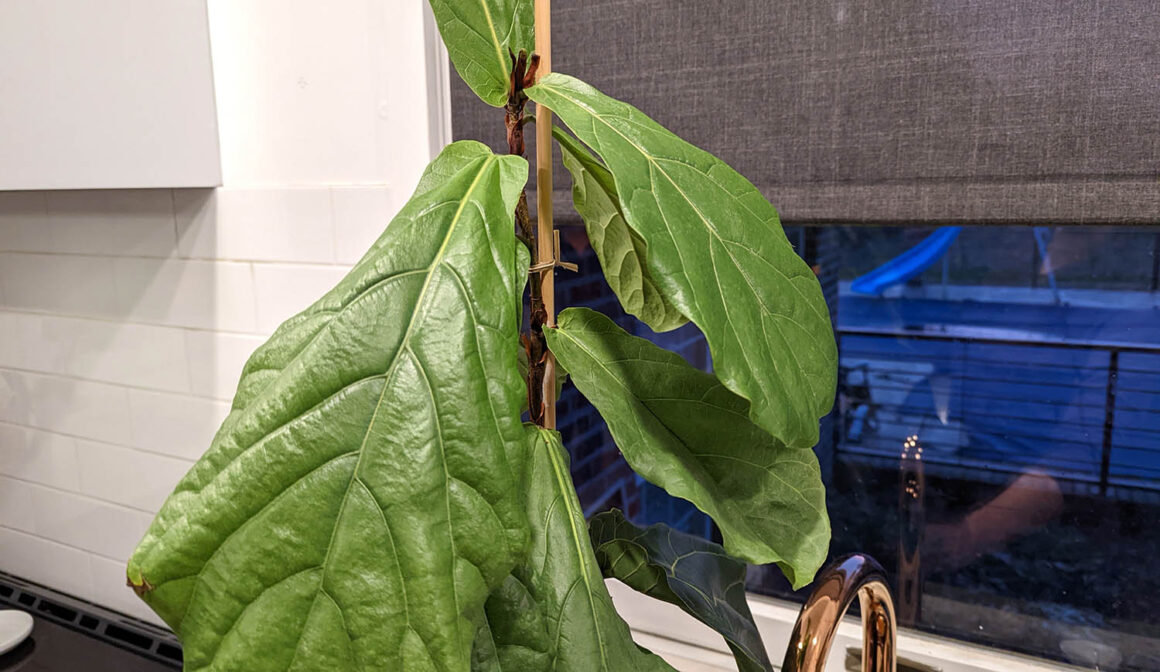
If the drought gets severe enough, your Fig will start letting leaves drop to reduce the amount of biomass it needs to keep alive. This usually starts near the bottom of the plant, affecting the oldest leaves first. (Read more signs that you’ve underwater your Fiddle Leaf Fig here.)
Unfortunately, underwatering can have a significant impact on newer growth. New leaves require a lot of water to grow, so if your Fig happens to be unfurling a brand-new leaf during a period of low or no moisture, it won’t have the water it needs to fully expand. This can cause stunted or deformed growth, stretches, or tears and, in some cases, leads to the plant dropping the new leaf altogether.
What To Do About It
If you suspect your Fig is dropping leaves because of drought-like conditions, you need to water your plant properly. Start by giving it a long, deep drink so that the potting soil gets fully saturated and any excess water drains from the bottom of the pot.
You should inspect the soil to see if water is actually being absorbed. Sometimes with Fiddle Leaf Figs, the soil it’s planted in can get old and compacted to the point where water has a tough time penetrating down to the roots. When you water your plant, most of the water runs between the root ball and the side of the pot and drains before any moisture is absorbed.
If you notice any drainage issues or compacted soil, it’s time to repot your Fig. Then, moving forward, water deeply only when the top two inches of soil have dried out. This ensures your Fiddle Leaf is getting all the water it needs without running the risk of overwatering and potentially having a bigger issue to deal with.
Too Little Light
Aside from overwatering, another common reason Figs suffer leaf drop is due to a lack of proper sunlight exposure. Fiddle Leaf Figs are native to areas that receive several hours of bright, filtered sunlight each day. Although these resilient plants can adapt to a certain extent, our homes are pretty dark by comparison when considering their natural habitat.
Over time, a Fiddle Leaf Fig suffering from a severe lack of sunlight will slow or stop any new, healthy growth. The plant will tend to start leaning towards any light source available, like a nearby window, and it will begin to produce leggy, weak growth in order to stretch as far as possible to secure more light. This isn’t healthy for your plant, and the overall look will be less than desired.
Because the plant does not have enough light, resources dwindle as the Fig struggles to photosynthesize efficiently, and energy is wasted on spindly growth. Left in this state long enough, your Fig may begin shedding leaves in a similar fashion to being underwatered. Again, this is a survival technique to conserve resources and reduce the amount of biomass the plant needs to keep alive.
What To Do About It
Luckily, your Fig will give you plenty of warning signs before it starts dropping leaves due to insufficient sunlight. The leaning and leggy growth are classic signs that your plant is seeking more sun exposure. So, if you notice either of these happening to your Fig, it’s time to find a brighter spot in your home.
You should try to find a spot where your Fig will receive filtered sunlight for at least six hours each day. A prime spot near a south-facing window is usually your best bet. Also, remember other things might be affecting your Fig’s light exposure. Light levels change throughout the seasons, so you may need to make adjustments to your plant’s placement every few months.
Obstructions, either outdoors or indoors, can impact exposure as well. Maybe a tree bloomed out fully, blocking sunlight from hitting an otherwise bright window. Perhaps the drapes were pulled for several days. After a long vacation, I once came home to some sad-looking plants because my wife pulled the curtains before we left, and they went without proper sun exposure for two weeks.
But by ensuring your Fig is placed in a bright room, you can easily avoid cases of leaf drop caused by too little light exposure. Read more about the ideal lighting setup for your Fiddle Leaf Fig here.
Shock
As many Fig owners quickly find out, Fiddle Leaf Figs are somewhat resistant to change. These plants tend to settle into the environment and conditions they are placed in and become rigidly opposed to any new circumstances they may find themselves in.
Even though they can adapt to a relatively wide range of different temperatures, light levels, humidity levels, or soil conditions, if any of these changes happen too fast, Fiddle Leaf Figs respond by going into shock, resulting in several leaves falling off the plant.
In most cases, shock occurs when the plant experiences extreme fluctuations in light and humidity. This most often happens when you first bring your Fig home from the nursery or plant shop, where light exposure and humidity levels tend to be much higher than what they experience in our dark, dry homes.
However, shock can happen any time you change your Fig’s environment too quickly. Aside from fluctuations in light and humidity levels, big swings in temperature, or exposure to drafts or heating vents, (all common occurrences within a home) can also push your Fig into shock.
As a result, the plant becomes stressed to a point where leaves begin to fall off. Often, this is an isolated event as the plant slowly becomes acclimated to its new surroundings, and you’ll usually see the plant recover after only a few dropped leaves.
What To Do About It
You can easily avoid shocking your plant and, therefore, shock-induced leaf drop by gradually introducing changes to your Fig’s environment. If you plan to move your Fiddle Leaf to a new location, do so over several days, slowly increasing the amount of time your plant spends in its new spot.
This way, your Fig acclimates to the new conditions, whatever they may be, over a long enough time to avoid pushing the plant into a stress state.
If you suspect your plant has been shocked by a recent change to its environment, give it time. Adding more or less light or changing the temperature rapidly again can only exacerbate the problem. Give your Fiddle Leaf Fig a few weeks to adapt to its surroundings and only make changes incrementally in the future.
Physical Damage
One last reason why Fiddle Leaf Figs might drop their leaves concerns physical damage sustained by the plant. There are many different ways a Fig suffers leaf damage, but regardless of the cause, it is important to know that damaged leaf tissue cannot be repaired, and if it is bad enough, the plant will eventually shed it to conserve energy.
There are a few common ways Figs end up with leaf damage. Falls, bumps, or drops can cause physical trauma to the leaves when we repot or move our Figs. Pest infestations can get bad enough that leaves get chewed, eaten, or burrowed into to the point that holes appear or the entire leaf dries out. Overexposure to sunlight can burn leaf cuticles and destroy leaf tissue.
Regardless of how the physical damage was sustained, your plant will spend an extraordinary amount of energy trying to repair that damage to avoid infection or the introduction of disease. If the damage is bad enough, eventually, the plant will drop the leaf, but it usually takes a significant time after the trauma before it recognizes that the leaf isn’t serving a purpose any longer.
What To Do About It
Although we all strive to be perfect houseplant owners, physical damage to your plants will happen. In most cases, it is not a huge concern, and your plant will do its best to deal with the trauma. However, we can help our Figs by pruning away any severely damaged leaves to conserve energy that can be better utilized by the plant in the form of new growth.
Be mindful of what caused the trauma in the first place, however. An isolated incident where you bumped the plant during a move is no big deal. However, if the trauma was caused by a pest infestation, you’ll want to be sure you treat your plant accordingly to avoid ongoing damage.
Will Fiddle Leaf Fig Leaves Grow Back in the Future?
Usually, the biggest question we all have after we watch leaves dropping off of our prized Fig is whether or not the leaves will grow back. Unfortunately, even after fixing the issue, the damage has been done, and it isn’t very likely you’ll see new leaves replacing what was lost.
Because Figs produce all their new growth from apical meristems (bud tissue that tops the stems and branches of the plant), most of the energy the plant puts into growth is directed to those structures. When a leaf is lost, your Fig will direct energy to push new growth at the top of the plant, but any leaves lower down on the plant are gone for good.
This is why prevention really is the best option and why you should investigate any time you see leaves dropping off your Fig. Correcting the issue quickly goes a long way towards preserving the plant. In cases where leaf drop has ravaged a Fig, people have had some success with pruning or notching to encourage new branches lower on the plant.
When a Fig gets cut or pruned, the interruption to sap flow within the plant activates hormones that turn on tissue production at the auxiliary buds along the stem, located at the leaf nodes of the plant. Usually, one to three nodes below a cut is activated and begin forming new branches, eventually producing new leaves.
Notching is another technique people use to encourage branching, albeit with a lower success rate. Notching involves using a sharp knife to cut a notch into the stem of the Fig, just above a leaf node. The idea is to activate the auxiliary bud located just beneath the notch to form a new branch. Both pruning and notching won’t promote new leaf growth to replace what was lost but can sometimes be an excellent option to kickstart new branch growth lower on the plant in an effort to fill in the bare spots.
How to Avoid Leaf Drop on Fiddle Leaf Figs in the Future
All of the reasons a Fig drops its leaves can be attributed to some aspect of care that has been neglected, so the key to preventing it from ever happening comes down to adopting a proper plant care routine.
I’ve said it before, and I’ll say it again: Get your watering habits sorted! The biggest favor you can do for your Fiddle Leaf is to learn the proper way to water it. Use the finger test, where you stick a finger down into the soil to determine when the top two inches have dried out and only water when it is dry to the touch.
Once the soil is dried out, give your plant a nice, deep drink, and then wait until it dries out again before you even think of grabbing the watering can. This method is the best way to determine when to water while avoiding extreme over-or under-watering; both can lead to leaf drop.
The next thing you must check is how well the soil and container your Fig is planted in drains. The watering method above only works when the plant has proper drainage, and if either of these is causing retention of too much moisture, you can easily create an overwatering situation.
You will occasionally have to repot your Fiddle Leaf as it grows, which is a perfect time to refresh the soil. Choose high-quality potting soil that has good drainage. To add more structure and airiness to the substrate, consider adding in a few handfuls of perlite or pumice. Alternatively, you can mix a little bit of cactus or succulent soil into your pot.
You also need to choose containers that drain well. When you water, you’ll be pouring an excess amount over the soil to properly wet it, and the extra needs to be able to drain out. This means your pot should have a drainage hole. If your pot is sitting on a saucer, you should pour off any extra liquid that fills it after a watering session.
Another surefire way to avoid leaf drop is to place your Fig in a location that gets plenty of bright, filtered sunlight for several hours each day. Your plant can handle as much indirect sunlight as you can give it and will even appreciate a few hours of morning or afternoon direct sun without an issue. (More on lighting Figs here!)
If you don’t have lots of light in your home or see your Fig is still struggling after being placed in the brightest location, you may want to consider supplementing with a grow light. There are tons on the market that can fit into desk lamps, and there are even free-standing lights for bigger plants, like Fiddle Leaf Figs.
Lastly, evaluate the environment your Fig is in. Take notice of how much light the room gets, where the heating vents are located, and whether or not the room feels dry. Remember that Figs don’t like change, so any time there are fluctuations in light, temperature, or humidity, your plant has the potential to freak out a bit.
Find spots for your Fig that avoids drafts and where the temperature stays between 60-80°F. If you live in a dry climate, you may want a room humidifier that can keep the levels between 30 and 50 percent. Humidifiers are usually pretty affordable, offer the most consistent method of adding moisture to the air, and will likely benefit all of your houseplants, not just your Fig.
If you need to move your Fig to a new location, remember to do so gradually so it has time to acclimate to its new spot. Despite their reputation for being finicky, Figs are actually pretty tolerant of a wide range of conditions, but they don’t adjust quickly. Slow, progressive introductions to new conditions keep your Fiddle Leaf Fig from stressing out.
Putting It All Together
Even though leaf drop on a Fiddle Leaf Fig can be scary, the good news is that it usually only takes a few small corrections in care to stop it from happening and prevent it in the future.
Just by making sure you are properly watering, providing your Fig with enough light, being mindful of where you keep your plant, and gradually introducing changes should be enough to avoid any significant leaf drop and will ensure you have full, healthy foliage covering your thriving Fiddle Leaf Fig. Best of luck!






